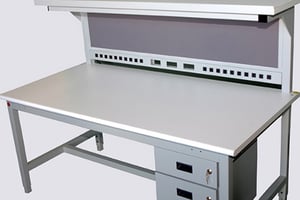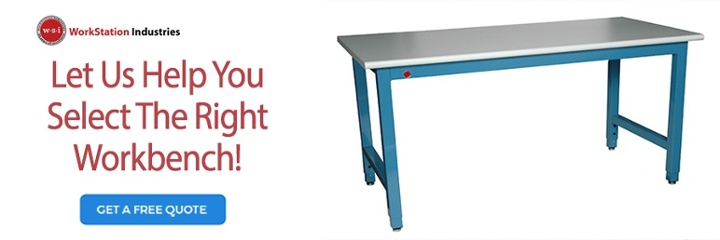Ergonomics play a major role in ensuring the safety and well-being of workers.
Yet while many manufacturers have procedures in place that focus on preventing accidents, many forget that injuries can result from poor ergonomics as well.
These injuries can have a significant impact on a company.
Some of the most recently available data shows sprains, strains and tears collectively was the leading type of injury in manufacturing in 2017. What many would consider minor injuries, compared to more serious incidents that can occur in this type of environment, can still greatly impact time on the job, worker efficiency and overall productivity.
Industrial furniture manufacturers know the importance of worker safety, which is why you are seeing more and more manufacturers emphasize ergonomics when designing workbenches and other types of furniture commonly found in industrial spaces.
Here are some of the reasons why industrial workbench manufacturers are placing a higher value on ergonomics and why as a company you should take advantage of this.
Worker Safety Is Prioritized
 How are ergonomics tied to worker safety? Ergonomics involves refining a product’s design so that it is better optimized for human use - to enhance both efficiency and safety.
How are ergonomics tied to worker safety? Ergonomics involves refining a product’s design so that it is better optimized for human use - to enhance both efficiency and safety.
Workplace injuries often occur because a work space isn’t properly ergonomically designed, with musculoskeletal injuries as one of the most common suffered by workers.
Having the right type of furniture that lessens the impact this type of work can leave on the body, and instead promotes natural body positions, is key to reducing workplace injuries of this nature. In the end, this also means a reduction in time loss due to inefficient practices.
A look at these stats from the Bureau of Labor Statistics speaks volumes on the importance of ergonomically-designed furniture:
- Musculoskeletal disorders accounted for 34% of days away from work (DAFW) cases in manufacturing in 2017. Though the numbers fell from the previous year, down nearly 2,000 cases, there were still 38,950 cases reported.
- The median number of days away from work in 2017 due to these injuries was 12.
- The rate of workers who experienced sprains, strains and tears in 2017 was 27.5 cases per 10,000 FTE workers.
- The median number of days away from work in 2017 who specifically experienced a sprain, strain or tear was 10.
Quality Of Life Matters
A worker’s health on the job also impacts their level of health outside the job.
When an employee must repetitively bend, twist and turn, painful injuries can not only impact worker safety and the overall efficiency of the work space, it can impact all areas of their lives.
When workers are injured, they typically must schedule an appointment with a doctor, who may then advise therapy sessions. Depending on the injury, the worker may be required to be cleared by a medical professional before coming back to work. In more severe cases, surgery may be required.
In addition to the toll these medical interventions can take on a person, workers may face a financial burden, as disability payments may not cover all of their salaries.
Customization Meets Individual Needs
Industrial furniture manufacturers know the importance of ergonomics in the workspace and are able to tailor their products to meet the needs of workers. This includes one of the most widely found pieces of furniture in industry, the workbench.
For example, furniture manufacturers can help optimize the workspace by including ergonomically-designed drawers in most types of workbenches. This simple move prevents repeated strains to the body because a high-quality design includes drawers that are easily accessible.
 Ergonomically adjustable hydraulic benches also have a positive impact on employee productivity in the workplace because it allows workers to choose whether they want to sit down or stand up at the bench simply by using a manual, hand crank or electric control.
Ergonomically adjustable hydraulic benches also have a positive impact on employee productivity in the workplace because it allows workers to choose whether they want to sit down or stand up at the bench simply by using a manual, hand crank or electric control.
In other words, there’s no need to adjust the shelves when lifting the work surface. The ergonomic design instead lifts the entire work surface and shelves at the same time.
Height-adjustable workstations also allow users to work using their bodies’ optimal neutral posture, which is the work posture where your body is at its strongest and most efficient.
Industrial chairs for the workbench is another important component to consider. Even in industrial spaces, employees spend long periods of time sitting. Ergonomically-supportive chairs feature sturdy frames, adjustable heights and comfortable backrests and seats.
These are just a few of the features to take into consideration when looking for workbenches and accompanying pieces of furniture that promote ergonomics.
Workforce Improves On All Levels
Product quality suffers when workers who experience discomfort routinely are not able to do their best work.
Product quality also may suffer when injured workers must be temporarily replaced by less experienced workers who aren’t as familiar with the equipment, product and/or procedures.
In the long run, this change in quality also impacts production and costs - something that often is not associated with worker injuries. Though an employee may temporarily not be on site, other workers and the overall efficiency of a production can be impacted by a single injury.
For example:
- Supervisors may need to spend additional time training replacement workers, taking time away from their other duties or increasing overtime costs.
- Co-workers may need to pick up additional work to make up for the employee who was injured to ensure work is completed.
- HR professionals will need to process worker’s compensation claims and file other necessary reports, as well as help find replacements for the injured worker quickly.
- Depending on the injury, management may need to spend extensive time investigating why an injury occurred and how it could impact other employees if not corrected.
What’s the take-away from all of this? It’s better to be proactive than reactive.
Effective ergonomics, especially in some of the most commonly used manufacturing furniture such as workbenches, can reduce the risk of injury and eliminate any associated costs.
Working with an industrial furniture manufacturer that supports ergonomics and incorporates the safety and well-being of workers into its designs is essential to improving productivity, maintaining quality and preventing costly injuries.


